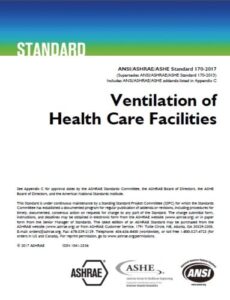ANSI/ASHRAE Standard 170-2017 Ventilation of Health Care Facilities
ANSI/ASHRAE Standard 170-2017 Ventilation of Health Care Facilities
ANSI/ASHRAE Standard 170-2017 Ventilation of Health Care Facilities offers guidance, regulation, and mandates to designers of health care facilities. The revised 2017 edition incorporates 12 addenda to the 2013 standard and includes the following significant changes:
- Addition of adiabatic humidifiers as an acceptable type
- Addition of a new type of exam room with lower requirements for less-acute applications
- Clarification around the prohibition of controls to change pressure relationships between spaces
- Reduction in requirements for electroconvulsive therapy procedure rooms
- Reduction in requirements for laboratories when allowed by certain calculations
- Higher requirements for higher hazard exhaust airstreams
- Coordination of space temperature requirements in the Sterile Processing Department with other industry groups
- Clarification of the definition of the primary diffuser array in operating rooms
The standard has also been reorganized into three sections: hospital spaces, outpatient spaces, and nursing home spaces. These changes were made to bring Standard 170 into alignment with the forthcoming 2018 FGI Guidelines.
You van also Read ANSI/ASHRAE Standard 120 Method of Testing to Determine Flow Resistance of HVAC Ducts and Fittings
ANSI/ASHRAE Standard 170-2017 Ventilation of Health Care Facilities Content
- Purpose
![ASHRAE Standard 170-2017 ASHRAE Standard 170,ASHRAE,Ventilation of Health Care Facilities,Health Care Facilities,HVAC,]()
- Scope
- Definitions
- Compliance
- Planning
- Systems and Equipment
- Space Ventilation—Hospital Spaces
- Ventilation—Outpatient Spaces
- Space Ventilation—Nursing Home Spaces
- Planning, Construction, and System Startup
- Normative References
- A—Operations and Maintenance (O&M) Procedures
- B—Informative References and Bibliography
- C—Addenda Description Information
ANSI/ASHRAE Standard 170-2017 Ventilation of Health Care Facilities scope
- The requirements in this standard apply to patient care areas and related support areas within health care facilities, including hospitals, nursing facilities, and also outpatient facilities.
- This standard applies to new buildings, additions to existing buildings, and those alterations to existing buildings that are identified within this standard.
- This standard considers chemical, physical, and biological contaminants that can affect the delivery of medical care to patients; the convalescence of patients; and the safety of patients, health care workers, and also visitors.


Comments are closed.